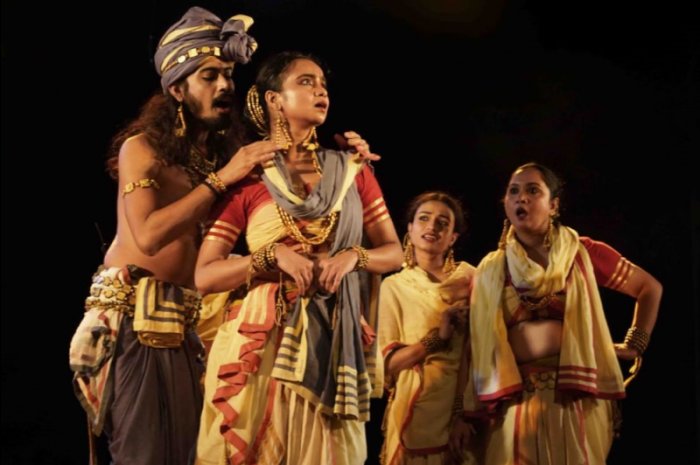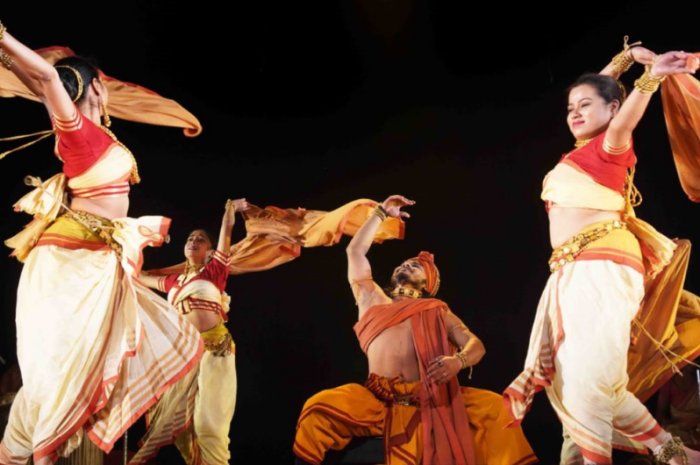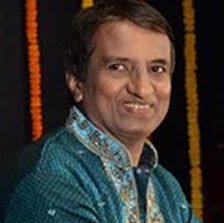
|   |

|   |
Aesthetic presentation of Samvatsar - Vijay Shanker e-mail: vijaydance@gmail.com November 25, 2023 A unique theatrical dance drama 'Samvatsar' directed by Piyal Bhattacharya, exploring the "marga natya" technique of geetam, vadyam and nrityam based on the Natya Shastra, portraying the evolution of mankind and the relationship with nature and seasons was enacted by over twenty dancers and musicians from Kolkata at the Studio theatre of Nita Mukesh Ambani Cultural Centre on October 7. 'Samvatsar' was particularly noteworthy for the aesthetic style of presentation with the inclusion of spontaneous and flowing movements, blending well with the music.   Samvatsar represents the cycle of 12 months on this earth. In the Indian system it is envisioned to have emerged out of the conjugation of Agni (cosmic casual energy) and Som (cosmic casual matter), just as the universe exudes out of the same coupling. Hence in Vedic terminology, this manifested universe is reckoned as "somaatmakam jagat". 'Samvatsar' is the key reason behind the existence of life, it is such a state that brings the expansion and sustenance of praan - the supra physical energy possessed by any matter. Owing to its combination of Agni and Som, Samvatsar is regarded as a Yajna, a creative process that emanates duality. Such exuding gets manifested at three levels, Agni aatmak (Grishma or summer), Som aatmak (Varsha or monsoon) and Agni Samantak (Sharad or autumn); late autumn is the transitional phase towards Shishir that manifests in Somantak. Vasant brings a merry harmonious blend of Agni Somantak stage that forms the crux and pinnacle of the presentation. While the interpretation of the evolution of mankind and the seasons was interesting with complete involvement of the dancers, the unusual and traditional music with the usage of rare musical instruments enhanced the overall appeal of the presentation. To develop the dramatisation aspect, brief inclusion of some short episodes could bring colour and brightness to the entire production. Pertaining to the technique of the presentation and to render form to the theme, a special mode of performance called Upa rupak has been adopted. Upa rupak stands as the creative extension of the rupak that was highly stylised and structured movements of the natya based on the Natya Shastra. Upa rupak also known as raag kavya, endows one with more creative ability in treating the content or the theme of the presentation and the prevalence of songs, music and dance, blending with acting marks its distinct characteristic. Broadly based on Bharatanatyam, it is the nritta aspect which is most important and quite different from other dance theatrical presentations.   Much like the formation of Adam and Eve in the Western classical culture, India has its own counterpart as Brigu and Angira, the primordial cosmic father and mother. Here, Bhrigu and Angira commenced the play to form the very first emanation. Brigu leaves the seed with Angira and the entire universe is born out of her womb. Thereafter gradually emerge the varied seasons and its relation to life, living and well-being. With the change of seasons and the theme, we can see dancers, actors, singers moving in and out of the scenario with highly stylised movements, dancing with fine coordination and synchronisation with dance and music. The cast credits goes to Sayak Mitra as Bhrigu, Manjira Dey as Angira, Grishma by Rudra Prasad Roy, Varsha by Sayak Mitra, Hemant by Akash Mallick, Vasant by Subhendu Ghosh, Devi by Pinki Mondal. The Natis were Sreetama Choudhary, Ruminti Jana Mondal, Amrita Dutta, Smita Majumdar, Debtunya Bera, Lopamudra Guha, Sagarika Adhya. Orchestral credits goes to Dardar and vocal by Piyal Bhattacharya, Kachchapi veena and Dhrupad Rabaab by Abhijit Ray, pakhawaj by Mithun Chakravarty, vocal by Seuli Chakravarty, shree khol by Joy Dalal, mattakokila veena by Subhendu Ghosh and flute by Suhatra Chaudhury. Lights design was by Soumitra Chakravarty and concept and direction by Piyal Bhattacharya. Samvatsar is a fine combination of music, dance, drama, histrionics, the clever and unusual usage of rare musical instruments that creates a unique ambience as the dancers sing, dance and deliver dialogues that keeps you spellbound and entertained taking you to a different era altogether.  Vijay Shankar is a Kuchipudi and Kathakali exponent, teacher, bilingual journalist, arts critic and actor. |